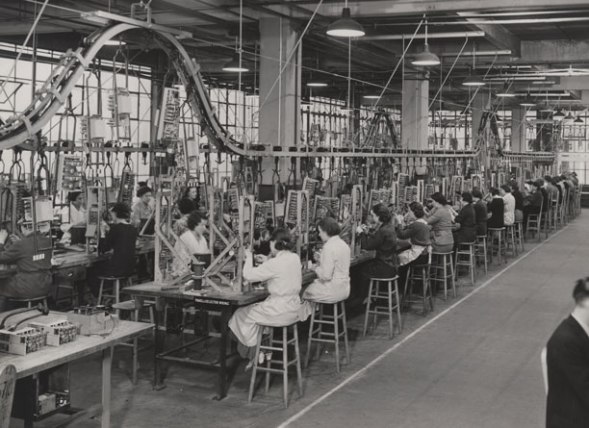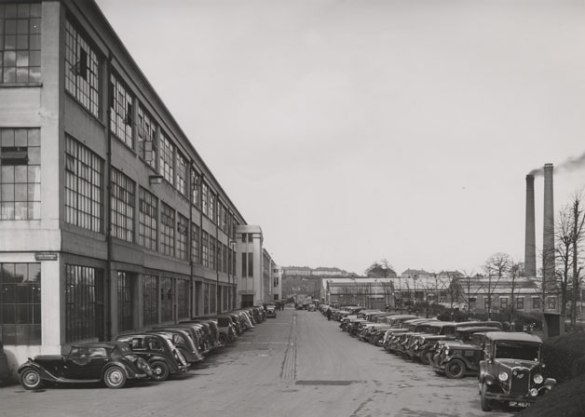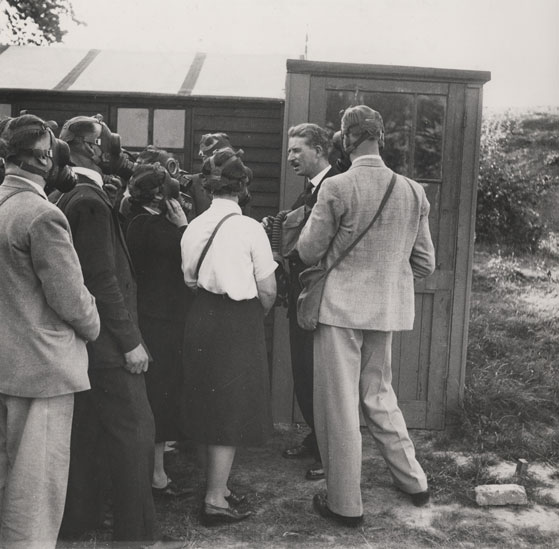STC, the British telephone, telegraph, radio, telecommunications, and related equipment manufacturer started out life in London in 1883 as International Western Electric (the UK arm of the US company Western Electric). It only became known as STC in 1925 after Western Electric sold off its international operations, and its new owner ITT Corporation, renamed its new UK operation.
The company’s first London manufacturing base was in North Woolwich which it set up in 1898 after purchasing a failing electrical cable factory. That facility made lead-sheathed cables, and also assembled equipment from components imported from Belgium and the US. Then in May 1922 the company acquired the John Tylor site at New Southgate and spent the 1920s and 1930s developing the facility in New Southgate which was the base for its telephone and radio equipment manufacturing business.
The image above shows STC’s ‘building number 3’ at New Southgate in 1936 and the image below shows a model of the whole site taken in 1938.

History of the New Southgate Site and a London Cemetery Station!
In 1855 the Great Northern London Cemetery Company established a 150 acre burial ground at Colney Hatch (now New Southgate). These 150 acres were around three-quarters of a mile north of Colney Hatch (later New Southgate) Station on the Great Northern Railway (GNR) main line just over 7 miles out of Kings Cross. The Colney Hatch Cemetery Company, as it was often referred to, had as one of its objects the betterment of funeral arrangements for the poorer persons who experienced much difficulty in finding the money for even the lowest class of funeral. One of the problems the company was trying to lessen was the retaining of the corpse in the house for upwards of a week because the bereaved family was unable to pay undertakers’ fees.
In 1859 the GNR provided two stations for the use of the cemetery company, one at Maiden Lane, near Belle Isle, King’s Cross, on railway land, and the other on cemetery land at New Southgate. The railway company then ran trains between these two stations for the transportation of coffins and mourners between the two stations. This service was not long-lived and ran from 1861 to circa 1870. The photograph below shows the New Southgate Cemetery Station and chapel buildings in 1884, which were known as The Retreat, New Brunswick Park, New Southgate.

Another photograph of the chapel and cottages forming The Retreat is shown below, viewed from Oakleigh Road, with the railway hidden behind the fence.

The cemetery company secured an Act in 1876 authorising the land on which the station at Colney Hatch was built to be used for other purposes and subsequently the railway works at both stations were demolished, and the buildings left derelict. The buildings at Colney Hatch only just survived into the 20th century before being demolished in the 1900-1910 period. The STC factory obliterated all trace of the original station.
Much of the information above has been sourced from the R G Lucas article, ‘Kings Cross Cemetery Station’, published in The Railway Magazine in October 1954 and which used one of the STC photographs now held by the IET Archives.
STC’s Early Years at New Southgate
[Extracted from the STC staff newsletter Standard News which became STC News in 1963]
The land on which the STC factory at New Southgate was located was mainly undeveloped until 1916, when J Tylor & Sons partially developed the site for the manufacture of lorry engines for the 1914-1918 war effort. After acquiring the site in 1922 STC spent the time until 1923 adapting the property for its various manufactures. In 1923 STC transferred part of the North Woolwich organisation to New Southgate. However, shortly before the transfer, instructions were given to erect a hut on the highest spot of STC’s land. That resulted on the night of 14/15 January 1923, in a distinguished company of engineers, together with representatives of the daily and technical press, sitting in the southwest corner of the first floor of Building 3 listening for 2 hours to H B Thayer, President of AT&T, and others talking by radio-telephone from 195, Broadway, New York, and it was recorded that this was ‘one of the most brilliant feats of engineering that the world had witnessed’. A plaque commemorating that event was situated in the entrance hall of Building 3 and it said:
“This plaque is set here to record that the first spoken word from the Western Hemisphere to these islands was received in the grounds of this factory on 14 January, 1923.”
Very little development of the property took place until after the trade recession in the 1930s, but then the company decided to consolidate its activities at New Southgate, Woolwich and other places, and a big expansion took place at new Southgate. From 1933 onwards STC purchased another 13 acres of land from the Cemetery Company and a farmer, Mr Morley. Another floor was added to Building 3 in August 1933, and Buildings 4 and 6 (Woodshop) and the Canteen were erected. Building operations continued at intervals until 1940 when Building 8 (the Radio Building) was completed. The images below show; candlestick phone production on the site; working on wiring and telephone exchange systems in 1936/37; the canteen in 1938; and the main roadway on the site in 1939.





The ‘War Years’ at New Southgate
Early in 1939 plans were made for the establishment of a self-contained Air Raid Precautions (ARP) organisation within the works. Directions were given by the Ministry of Aircraft Production, and Executives were allotted to take charge of the various services i.e. Heard Warden, Plant, Medical, Evacuation, Fire, Gas, Roof Spotting and each of these services received specialised training. The images below show ARP staff in gas masks (1938/39), the Air wardens room (1945) and the plane models used by ‘spotters’ during the war to identify whether planes were ‘friendly’ or ‘enemy’ planes.



Before the outbreak of WWII, STC completed an effective black-out of the factory and this enabled work to continue uninterruptedly both by night and during the day. Headquarters, which was built of sufficient strength to withstand anything but a direct hit, was connected to all parts of the works by an elaborate loudspeaker system, and the factory was manned throughout the war period by seven teams each on a 24-hour shift of duty.
Incidents tended to be few and far between but the worst incident occurred on 23 August 1944, when a flying bomb fell between Buildings 6 and 8, causing 30 deaths and 300 injured. The next evening a flying bomb fell in the middle of the north field but did little damage.
For anyone wishing to consult these New Southgate photographs within the STC corporate collection of photographs, they have been catalogued with reference NAEST 211/2/28, and they can be viewed at the IET Archives, by appointment.

January 30, 2019 at 5:56 pm
A very good account of the start of S.T.C, Many Thanks,
LikeLike
September 26, 2019 at 9:22 pm
My father worked for STC. He was an IEE member. His name was John Norman Briggs. He always said that he was in a reserved occupation during WW2, working on the development of radar. Is there any corroborating evidence of this?
LikeLike
September 27, 2019 at 11:48 am
Thank you for your enquiry, Elizabeth. I have sent you an email asking for more details so we can investigate this for you. Please check your junk mail if it isn’t in your inbox.
LikeLike
April 17, 2020 at 11:02 pm
My father may have possibly worked for STC during the war, and as Elizabeth Briggs above, he was in a reserved occupation during WW2. He was CLJ Reynolds DOB 16/7/1904 (I think). Would you have any information regarding him? It is very hard to find anything as I was very young when he passed away in 1968.
LikeLike
July 15, 2020 at 6:59 am
My grandfather – Lawrence Webb – worked for STC and retired in 1962. Can anyone give me any further information? My email address is cdwebb63@gmail.com. Many thanks in advance!
LikeLike
December 9, 2020 at 4:42 pm
I started there straight from school July 1977. I worked in the Computer department. I was made redundant in July 1990.
LikeLike
July 13, 2023 at 11:58 am
Hello Lesley, Did you know Tony Evans, he was my father and worked in the computer department at New Southgate
LikeLike
February 24, 2021 at 1:29 pm
My father Albert Hayes worked for STC in London. They moved out of London during the war to Leicester and my father moved too. When the war was over STC moved back to London. My father was offered a job back in London but he decided to stay in Leicester and took redundancy. What date did they move out of London? and Where abouts in Leicester were they based? I would love to find out more.
LikeLike
June 15, 2021 at 10:19 pm
I worked there in the early 80s. The buildings had not changed much since the 30s. A friend worked there during the war as an apprentice. He had many a story about spotting on the roof off Building 3 watching German planes follow the railway line north and taking pot shots at them.
LikeLike
July 19, 2021 at 11:01 am
I worked at the New Southgate site around 1997 when manufacturing operations were being transferred from Benfleet to the new 45 Division.
Notable events:
Watching the Ally Pally fire from the roof of building 3.
The second and third floors of building 1 dropping 6 ? Inches one Saturday morning.
The classic site fire engine being replaced with one based on a Land or Range Rover.
LikeLike
August 23, 2021 at 8:31 am
My husband’s father was Henry Stephen Talbot born 08 October 1917 was working at STC when he married in 1939, his marriage certificate states that he was an Electrical Inspector. Sadly, he died in 1947 aged just 30 years. My husband thinks he may have worked in the tool department but he was only 3 years old when his father died and knows little about him really. Any information you could provide about his working life would be so appreciated. Thank you.
LikeLike
September 9, 2021 at 1:10 pm
Thank you for your email, Teresa.
Unfortunately, the STC papers held at the IET do not include information relating to STC employees. I did looks at the IET’s membership records and was unable to find your father-in-law’s name. I’m sorry we were unable to help you further.
Best wishes,
Aisling O’Malley
Archivist
LikeLike
March 3, 2022 at 12:07 am
Hi my uncle worked there in 1970 /1982 would you still have any record of him working there and what he was doing his name was William Marlow
LikeLiked by 1 person
March 7, 2022 at 3:09 pm
Dear Kel ann,
Thank you for reaching out. Unfortunately, the STC papers held at the IET Archives do not include staff records. There are records relating to the employment figures (UK0108 NAEST 211/01/01/19), staff newsletters that span from 1963 to 1983 (UK0108 NAEST 211/01/06), and photographs relating to staff events (UK0108 NAEST 211/02). However, no records directly relating to an individual staff member.
Best wishes,
Aisling O’Malley
IET Archivist
T: +44 (0)20 7344 8407
theiet.org
IET London: Savoy Hill House
7-10 Savoy Hill, London, WC2R 0BU
United Kingdom
LikeLike
January 20, 2023 at 11:48 am
I worked at Standard Telephones and Cables at New Southgate from 1979-1995 when owned by ITT, and later STC PLC. STC Telecommunications at New Southgate had best practices and processes and was such a great place to work. Unfortunately the acquisition of ICL did not go well nor did the Northern Telecom/Nortel Networks years which were frought. I joined the STC Athletics & Sports Club’s Rifle and Bowls Sections and have a 1952 photo of the founding bowling members.
LikeLiked by 1 person
March 13, 2023 at 6:09 pm
What great memories, we have some super photographs of the staff too, none of the bowling or rifle clubs though.
LikeLike
February 19, 2023 at 12:13 pm
My late mother worked at STC New Southgate during the Second World War. She was working on the day that the V1 hit the factory. She wrote about the day, in later years. A copy of which I have. She was so lucky to escape injury, though she was temporarily deafened for a few days. My uncle and his wife also worked for STC during the war.
LikeLiked by 1 person
March 13, 2023 at 6:09 pm
Thank you for sharing this sad yet very important story.
LikeLike
February 22, 2023 at 5:25 pm
Does anybody remember the apprentice training school outside the main gate, under the very strict watchful eye of Fred Painter and his second in charge whose name unfortunately I can’t remember. It was nearly opposite the main gate, on the other side of the road, in what I remember was an old chapel. I was in the training school around 1960 at the start of my apprenticeship, ending up finally in Building 3 in the drawing office. My father, Don Church, was one who worked all his life in STC, and was classed as having a reserved occupation – he was an air raid warden during the war.
LikeLiked by 1 person
March 13, 2023 at 6:10 pm
Thank you for sharing your story with us. STC was a huge employer. I hope someone can help you with your enquiry.
LikeLike
October 14, 2023 at 10:55 am
I
LikeLike